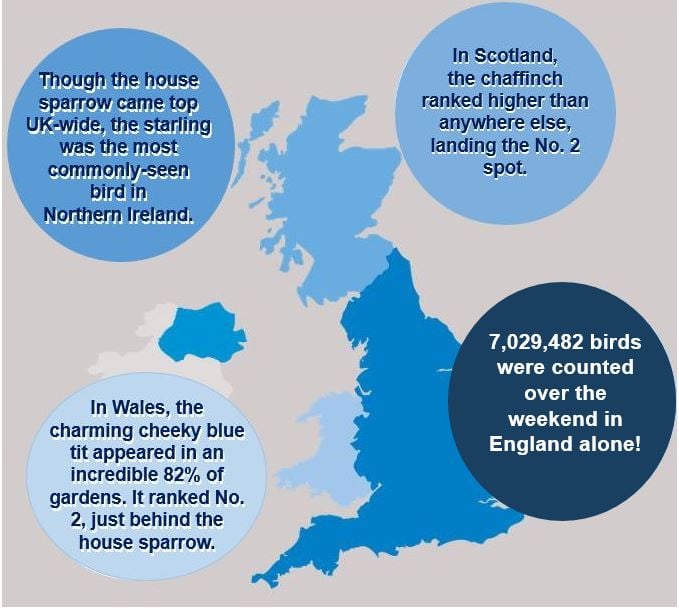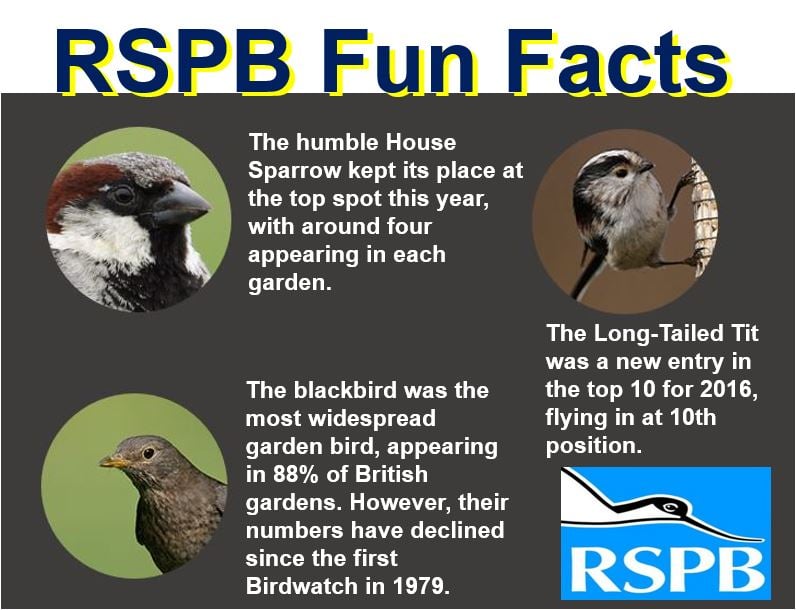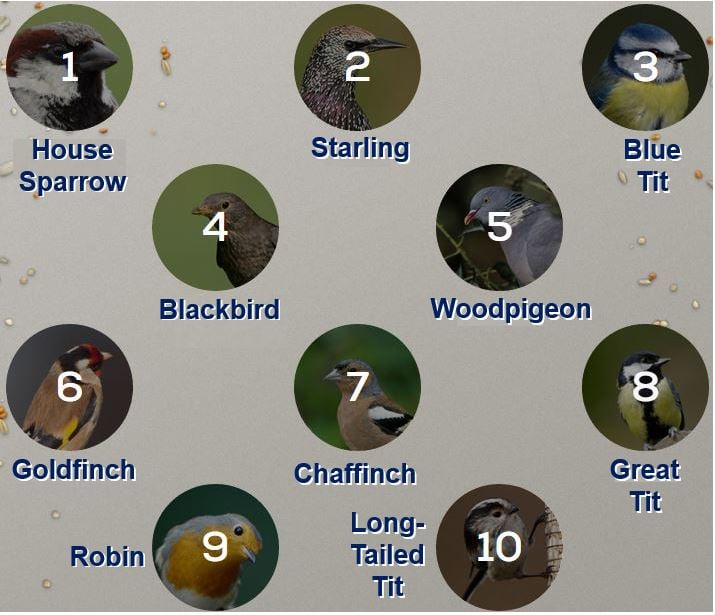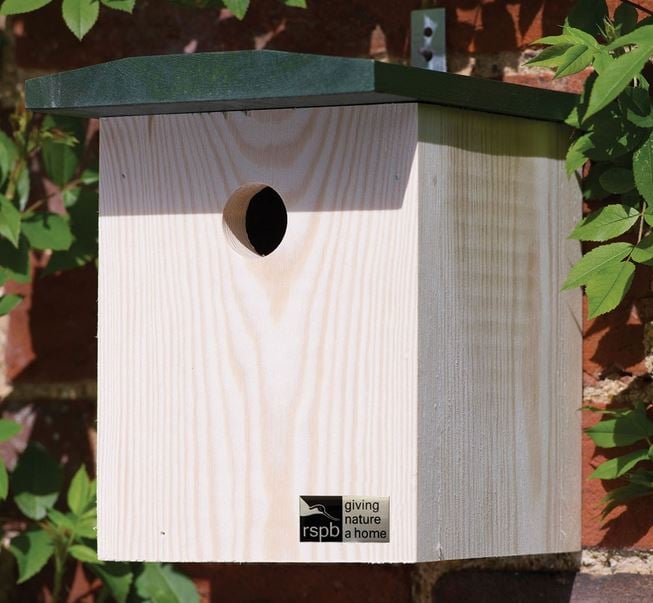Small garden bird numbers are up significantly thanks to the mild weather during the months leading up to January 2016, says the RSPB (Royal Society for the Protection of Birds). Recorded sightings for long-tailed tits rose by 44% in 2015. Several other garden bird species, including the coal tit and great tit, benefitted from the warmer weather.
The most commonly-sighted bird in the UK’s Big Garden Birdwatch is the house sparrow again, followed by the starling and blue tit.
More than half-a-million people joined the largest garden wildlife survey in the world – turning their eyes to their gardens to watch and count a bumper 8,262,662 birds during the 37th RSPB Big Garden Birdwatch. Several exciting and interesting changes have been reported among Britain’s most popular garden birds.
 Bird populations vary between England, Wales, Scotland and Northern Ireland. (Image: Big Garden Birdwatch 2016)
Bird populations vary between England, Wales, Scotland and Northern Ireland. (Image: Big Garden Birdwatch 2016)
Long-tailed tit back in top ten
The tiny long-tailed tit has entered the Big Garden Birdwatch top ten – for the first time since 2009. The number of sightings in people’s gardens across the country has increased by 44%.
The long-tailed tit (Aegithalos caudatus), a highly social species, probably benefited from the mild temperatures during the months leading up to January’s Birdwatch. It was observed in more than one-quarter of all participants’ gardens, says the RSPB.
RSPB ornithologists (bird experts) are linking the greater number of sightings of long-tailed tits, as well as several other smaller garden-bird species such as the great tit and small tit, to the very mild late autumn and early winter preceding the 2016 Birdwatch.
Small birds suffer when temperatures are very low
The long-tailed tit as well as other small, insect-eating birds are especially susceptible to the cold, because when the ground is hard, frosty or under snow, their food is more difficult to get to. When conditions are milder, small bird survival rates increase considerably.
 This year’s Birdwatch had mostly good news, but also worrying information regarding some bird species. (Image: Big Garden Birdwatch 2016)
This year’s Birdwatch had mostly good news, but also worrying information regarding some bird species. (Image: Big Garden Birdwatch 2016)
RSPB Conservation Scientist, Dr Daniel Hayhow, said:
“This year’s survey was another brilliant year for the Big Garden Birdwatch. More than half-a-million people took part counting a bumper 8.2 million birds, proving us with valuable data which helps to build a better picture of how our garden birds are doing.”
“The weather can have varied effects on different groups of birds in terms of behaviour and habitats used. The increase in long-tailed tit sightings, along with other smaller garden birds, just goes to show that in the absence of very cold weather these species can survive the winter months in much great numbers.”
“The warmer temperatures have made it easier to find food, like insects, which in previous colder winters would have been harder to come by because of frosts and snow.”
Garden feeders boost winter bird survival
When temperatures drop during the winter months, birds struggle to find food in the wider countryside and depend more on garden feeders.
 Top ten British garden birds. (Image: Big Garden Birdwatch 2016)
Top ten British garden birds. (Image: Big Garden Birdwatch 2016)
Smaller birds have adapted to feeding on peanuts and seeds at hanging feeders and bird tables. Since 2006, great tit and long-tailed tit numbers observed in British gardens have risen by 13% and 52% respectively.
Regarding bird feeders and making sure they are well stocked, Dr Hayhow said:
“The increase in numbers of sightings of these smaller garden birds highlights the importance of a well stocked bird feeder for some species. Long-tailed tits only started using garden feeders in recent years, and now more people are spotting them in their gardens as this behaviour develops.”
Concern for starlings and song thrushes
Not all the news is good, the RSPB informed today. Some garden favourites continue to struggle. During the Big Garden Birdwatch this year, sightings of well-known species such as song thrushes and starlings have experienced another decline.
 You can help British birds by placing a bird nestbox in your garden. (Image: RSPB)
You can help British birds by placing a bird nestbox in your garden. (Image: RSPB)
Since 1979, when the first Birdwatch occurred, sightings of starlings and song thrushes have fallen by 81% and 89% respectively.
RSPB Wildlife Advisor, Ben Andrew, added:
“A lot of our favourite garden birds are struggling and are in desperate need of our help. Gardens or outdoor spaces are an invaluable resource for many species – they can provide a safe habitat and enough food and water to survive – which are likely to have a significant effect on their populations.”
Record number of school-children participating
The Big Schools’ Bridwatch, a nationwide parallel event, reported similar record-breaking sightings, with more children and schools participating than ever before. More than 90,000 school-children spent one hour in nature counting birds.
 Children love helping out on nature projects. Get your kids involved – it could be the beginning of a lifetime passion. (Image: RSPB)
Children love helping out on nature projects. Get your kids involved – it could be the beginning of a lifetime passion. (Image: RSPB)
The most commonly-sighted bird among school-children was the blackbird, for the eighth consecutive year, followed by the starling and woodpigeon.
The Big School’s Birdwatch and the Big Garden Birdwatch form part of the RSPB’s Giving Nature a Home campaign, which aims to address the housing crisis that Britain’s threatened wildlife is facing.
The RSPB is asking members of the public to provide a place for wildlife in their gardens or outdoor space. This could involve putting up a nest box for birds, building a home for hedgehogs, or creating a pond for frogs.
Video – Big Garden Birdwatch 2016
The RSPB says it has just finished analyzing the results of the Big Garden Birdwatch.
